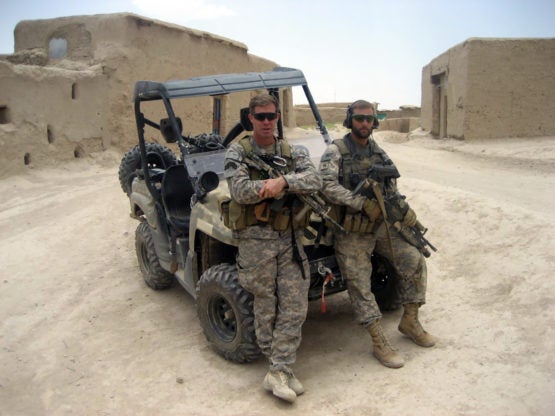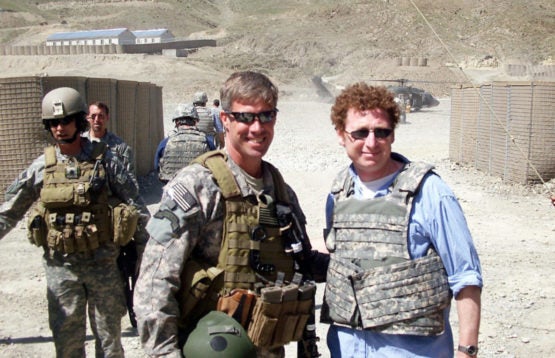Special forces veteran and Stanford scholar applies data and scholarship to conflict
Special Forces veteran and Stanford scholar Joseph Felter underscores the importance of rigorous data and scholarship in understanding violent conflict and reducing casualties.
Special forces veteran and Stanford scholar Joseph Felter will never forget when U.S. Army General Stanley McChrystal was briefed on a study Felter had co-authored concluding that civilian casualties inflicted by international forces in Afghanistan increased insurgent violence.
McChrystal was gripped by one finding in particular in the analysis by Felter and his colleague, Radha Iyengar: If the International Security Assistance Force (ISAF) could eliminate incidents that left at least two civilians dead, then there would be one less insurgent attack over the following six weeks.

Joseph Felter (left) in southern Afghanistan’s Kandahar Province, where he was the Counterinsurgency Advisory and Assistance Team commander. (Image credit: Courtesy Joseph Felter)
“General McChrystal started tapping his microphone and said to his field commanders joining the video conference call from across Afghanistan, ‘Everyone, look, this is what I’ve been preaching since I’ve been here: We have to protect the population,’” recalled Felter.
At the time, Felter was deployed to Afghanistan as the first commander of the ISAF Counterinsurgency Advisory and Assistance Team. He recruited Iyengar, along with other scholars, to help the team better understand problems they faced on the ground.
While Felter and his fellow operators in the field had a “gut feeling” that civilian casualties were going to undermine their mission in Afghanistan, they did not know to what extent. But the new study provided empirical proof that harming civilians directly led to an increase in casualties among U.S and other NATO-allied forces.
“It was a moment that showed the value that high-quality, rigorous evidence can provide in understanding conflict dynamics,” said Felter, who is now the William J. Perry Fellow at the Center for International Security and Cooperation (CISAC), a research and policy program within the Freeman Spogli Institute for International Studies (FSI).
Felter’s research in Afghanistan is one of many studies he has conducted as both a scholar and a service member. For most of his career, these two worlds have closely intertwined, with each experience building on and informing the other.
“We are not going to do better in these types of conflicts by fighting harder. It’s going to be about fighting smarter,” Felter said.
Building academic, military bridges
It was as a doctoral student in the Political Science Department in Stanford’s School of Humanities and Sciences during the early 2000s that Felter saw the value that evidence-based, methodologically rigorous scholarship can offer military leaders and policy makers as they address the complexities of contemporary conflict.
At the time, Felter’s two advisors, professors James Fearon and David Laitin, had published their seminal study on how and why civil war and insurgencies occurred. They argued that a financially and bureaucratically weak state—not religious or ethnic infighting—led to discord. Through their data-driven analysis, they developed a proxy to predict violent uprisings by looking at a country’s Gross Domestic Product.
Felter was captivated by Fearon and Laitin’s findings. He saw an opportunity to expand on their discoveries using insights he had gained advising military and internal security forces across Southeast Asia as a Special Forces commander. The relationships he developed while serving as a military attaché in the Philippines helped provide him access to a trove of incident-level conflict records. With this information, he was able to compile a high-quality micro dataset that helped him further understand indicators of insurgency.
Felter’s research found that it wasn’t only how much money a state had that mattered. More important was how the state invested that wealth in its military and security forces in terms of leadership, discipline and professional training.
“If we can get more, better-quality microdata into the hands of scholars who can really work with it and test hypotheses, it can help us advance our understanding of the roots of conflict and how we can intervene to reduce its tragic costs,” said Felter, who has since been committed to helping other scholars – including students – gain access to the same level of granular information he had when doing his doctoral work.
After Felter earned his PhD in 2005, he directed the Combating Terrorism Center at West Point until 2008. One of the projects he worked on there was a deep dive investigation into some of the 700 records seized in a 2007 raid near Sinjar, Iraq. Among the critical discoveries to emerge from Felter’s analysis was a more detailed understanding of how Al Qaeda recruited foreign fighters and their smuggling routes into Iraq.
In 2008, after a tour with a special operations task force in Iraq, Felter returned to Stanford as a National Security Affairs Fellow at the Hoover Institution. He then deployed again to Afghanistan to command the ISAF Counterinsurgency Advisory and Assistance Team reporting to U.S. Army Generals Stanley McChrystal and David Petraeus.
While deployed, Felter bolstered his unit’s capabilities by bringing scholars into the field, including economists like Iyengar, to work with his operators and counterinsurgency advisors. He also brought out his former Stanford classmate Jacob Shapiro and Eli Berman, who conducted an in-depth study into the effect of small-aid projects on counterinsurgency effectiveness, among other issues.

Joseph Felter (left) with Eli Berman, professor at UC San Diego, as they leave a Special Forces outpost in Eastern Afghanistan. Berman was among the academics who helped Felter study aid effectiveness and counterinsurgency efforts.
These efforts have not come without challenges, Felter noted. Sometimes the operators and scholars were suspicious of one another.
“But when you get people together, it all comes down to human nature, building bridges, building relationships and building trust,” Felter said.
Throughout this period, Felter also continued his own scholarship. He became a research fellow at the Hoover Institution in 2009 – a position he still holds in addition to the CISAC appointment that he has held since 2011. He is also co-director at the Empirical Studies of Conflict Project at Princeton University, which he helped launch with Shapiro in 2009. He co-authored “Small Wars Big Data” in 2018 with Shapiro and Eli Berman, which presents findings from more than a decade of research on the dynamics of internal conflict.
In 2017, Felter followed U.S. Secretary of Defense James Mattis to the Pentagon and served as deputy assistant secretary of defense for South Asia, Southeast Asia and Oceania until 2019.
Using, understanding technological challenges
Felter draws on this experience to give his Stanford students a first-hand look into challenges facing the U.S. military, as well as an opportunity to help tackle those challenges by working with defense and intelligence agencies.
Just as he brought scholars into the field when he was deployed overseas, Felter wondered if there was a way to do something similar with his students.
In 2016, he helped develop and launch Hacking For Defense, a 10-week graduate-level course that partners students with the Department of Defense and other government agencies to solve that daunting security problem. The course applies the entrepreneurial “Lean” methodology that Steve Blank, an adjunct professor in the Department of Management Science and Engineering, developed for start-ups to the defense sector. The student teams address problems through a “beneficiary discovery” process, where stakeholders raise the issues they experience and together develop solutions through rigorous experiments and iterative problem solving. As the course description describes, students are expected to get their hands dirty.
For example, one problem that Stanford students in the spring quarter course worked on was how to best bring power to soldiers fighting on the ground. For instance, batteries are heavy, adding up to 20 pounds to a soldier’s already burdensome load, as well as bulky. After speaking with more than 140 people across various sectors — from battery experts to soldiers in combat — one team came up with a more lightweight, flexible battery design. Another team looked at how to navigate in GPS-denied areas.
“You can’t overstate the creativity and genius of diverse Stanford teams when they put their heads together and use a powerful methodology to try to help their military sponsor understand their problem and solve it,” Felter said.
The Hacking for Defense curriculum is now sponsored by the Department of Defense and has since rolled out to some 40 colleges and universities nationwide.
Felter is also teaching a new class this fall with Blank and CISAC affiliate Raj Shah that examines how technology will change the military’s approaches to conflict. The course focuses less on developing new technology and more on examining how militaries will adopt new doctrines and operational concepts using technological advancements in areas like autonomy and cyberspace.
In the months ahead, Felter also plans to continue expanding opportunities for further collaboration between serving and former officials and the scholarly community, including ways to inform international policy.
“For me personally, I really enjoy working across the different lanes from academia to policy to practitioner,” said Felter. “You don’t want to get into a rut, you want to make sure you are always challenging yourself and getting into different lanes where you can have impact.”
